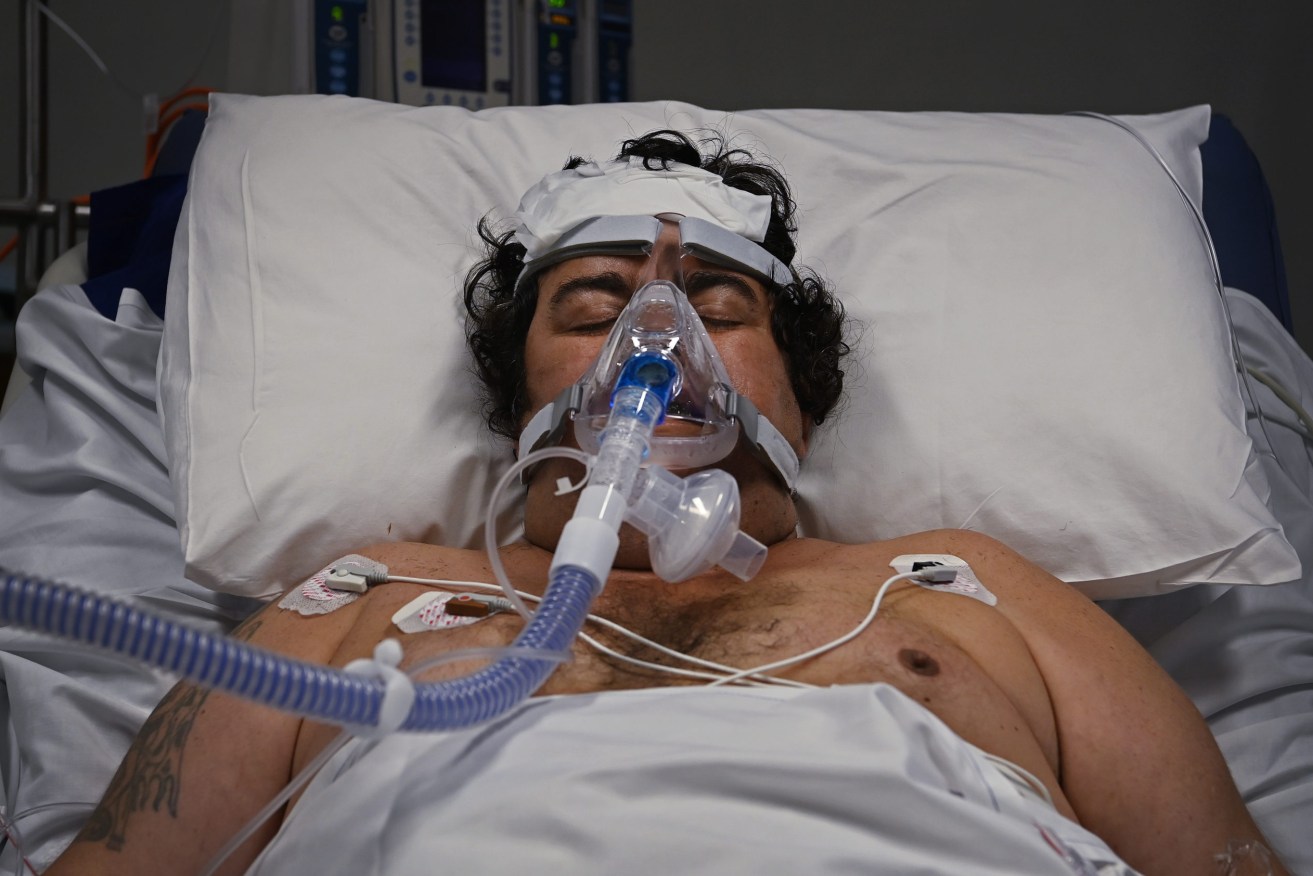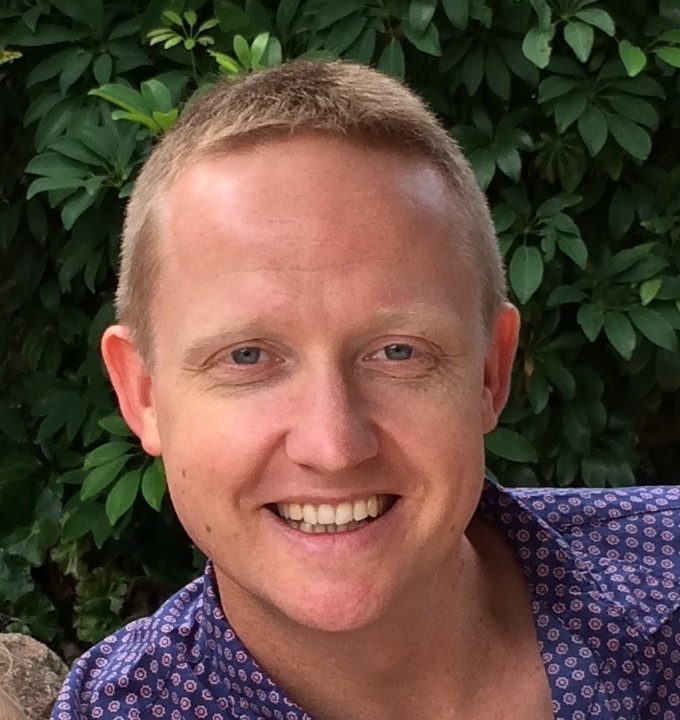‘Not prepared’: Doctors’ COVID warning for SA
Emergency doctors say South Australia’s embattled healthcare system is “not adequately prepared” to cope with an inevitable COVID outbreak once the state begins opening its borders.


A COVID-19 patient in the ICU of St Vincent’s Hospital in Sydney. Photo AAP/Kate Geraghty/SMH/St Vincent’s Hospital
Australasian College for Emergency Medicine SA faculty chair Dr Mark Morphett told InDaily clinicians had concerns the state’s plan for managing the pandemic was “no longer sufficient in the face of an outbreak of the Delta variant, or a transition to living with COVID-19 in the community”.
“As the narrative now shifts away from prevention to an acceptance of living with COVID-19, our clinicians on the frontline are concerned that the South Australian health system – which barely copes with its current business-as-usual operations – is not adequately prepared for a COVID-19 outbreak, resolved other than by lockdown,” he said.
“We are also worried that the health system is not prepared to accommodate the inevitable increase in COVID-19 cases as vaccination rates increase, borders open and communities look to ‘open up’.
His comments came as the paramedics’ union tweeted a photo from the newly-expanded Flinders Medical Centre last night showing ambulances banked up outside the ED, with “15 uncovered emergencies”.
“People with life threatening conditions, no ambulance on the way,” the Ambulance Employees Association of SA said in its tweet.
This is FMC right now.
With 3 more ambulances out of shot.
With 15 uncovered emergencies. People with life threatening conditions, no ambulance on the way.
Please stay safe tonight SA. Our ambulance service & health system certainly isn’t. #istandwithourambos #saparli pic.twitter.com/G1wmRaBK2R
— Ambulance Employees Association (SA) (@aeasa1981) September 16, 2021
Premier Steven Marshall last weekend said SA was aiming to open its borders to COVID-hit states including New South Wales and Victoria once 80 per cent of the state’s population aged 16 and over was fully vaccinated, likely before Christmas.
He said that travellers from specific local government area exposure locations could still be locked out.
Marshall has since said the government was now planning to wait for even vaccination coverage across local government areas in SA, rather than opening once the state reached an average 80 per cent vaccination mark, because there was concern about pockets with low rates.
Chief public health officer Professor Nicola Spurrier has also since stressed the importance of “equity” of vaccination rates across local government areas before opening borders.
It came after leading epidemiologist Professor Adrian Esterman warned South Australia “will never be back to pre-COVID” and residents would have to learn to live with restrictions such as social distancing and mask-wearing well into the future.
Morphett said COVID continued to pose “significant risks to communities and health systems and will continue to for some time”.
“As we have seen recently in Australia and New Zealand, outbreaks can happen at any time, in any place,” he said.

Dr Mark Morphett.
Photo: Supplied
The college is urging the State Government to focus on a “whole of healthcare system approach” to prepare for cases and to support current demand.
Morphett said there had been a focus in other states on intensive care unit capacity, staffing and ventilator numbers.
He said while this was important, it was also vital to put more resources into other parts of the hospital and healthcare system.
“In the case of a Delta outbreak, some estimates based on presentations overseas show that emergency departments could see over five times more COVID patients than ever make it to ICUs,” he said.
“EDs will still also see their usual patients with significant illness or injury requiring hospital admission and this must be prepared for.”
Morphett said authorities needed to recognise that dealing with COVID cases would come on top of other “usual business” of the health system.
“As resources are used and diverted to manage the surge in COVID-19 patients, there are a multitude of flow-on effects on the care that can no longer be provided for non-COVID patients,” he said.
“These include unavailability of community and outpatient services, inpatient and ICU beds, and cancellation of surgeries.”
Morphett said “whole of system” planning was necessary, including support for primary, community, ambulance and emergency department care.
“We must learn from the experiences of our colleagues interstate and overseas,” he said.
“This includes an observation that symptoms of the Delta variant are not restricted to respiratory complaints.
South Australia currently sends any COVID-positive patients requiring hospitalisation to the Royal Adelaide Hospital but Morphett said “any notion that a particular hospital can be kept ‘COVID-free’ will not be able to be maintained in the face of a Delta outbreak”.
Morphett also said it was increasingly evident that SA would require strong systems in place for supporting patients who do not require hospitalisation, “including at-home care and monitoring to allow early detection of deterioration”.
“South Australians will expect access to high quality healthcare, irrespective of COVID-19 outbreaks,” he said.
Morphett said authorities also needed a better plan in place to support already overworked healthcare staff.
“We know that some of South Australia’s overburdened frontline healthcare workforce are already experiencing burn-out,” he said.
“Their safety and wellbeing must be considered in the state-wide response and in plans to meet South Australian public expectations,” he said.
“This must include clear and consistent guidelines in relation to the protection and potential quarantining of healthcare staff who may come into contact with COVID-19 patients, clear and upgraded PPE guidelines and workforce plans, supports and contingencies.”
To support a “depleted” workforce in SA, Morphett called for “cooperative action from all governments to support healthcare workers to cross state and national borders, and to assist overseas healthcare workers to reach Australia”.
He said this should include the creation of extra places in quarantine facilities, on top of those already available for returning Australians.
“Where plans exist for staff to be redeployed to areas of need, this process, including induction and orientation, needs to be underway now,” he said.
Morphett said clinicians “applaud” the efforts made by SA Health in the vaccine rollout, including opening up jabs for children aged 12 and over.
“The SA Government must also focus on equity of vaccine access and uptake, with a particular focus on areas and regions where vaccination rates lag, with a particular focus on vulnerable community members and Indigenous communities,” he said.
A State Government spokesperson said “these matters are being actively discussed at both National Cabinet and the national meeting of health ministers today”.
In a statement, SA Health said: “Contingency plans across the entire healthcare system have been in place since the beginning of the COVID-19 pandemic.”
“We revise and adjust our planning and response as the pandemic progresses to ensure we can continue to protect South Australians from the spread of COVID-19,” SA Health said.
An SA Ambulance Service spokesperson said the organisation “continues to support local health networks to improve the flow through their hospitals and to enhance our own service”.
“Next month, nine additional paramedic crews will be on board in the metro area in the next phase of our recruitment of 74 additional FTE,” the spokesperson said.
“They will also be trialling a new 10 hour roster model.
“By spreading out shift patterns, we anticipate that we will be able to bolster our response capacity and able to better match patient demand.”




